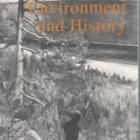Sviden, John, and Mats Eklund. “From Resource Scarcity to Pollution Problem: The Production and Environmental Impact of a Swedish Alum Works, 1723–1877.” Environment and History 2, no. 1, Lammi Symposium special issue (Feb., 1996): 39–61. doi:10.3197/096734096779522437. Wood scarcity at Lovers Alum Works (LAW) restricted the amount of alum produced during a large part of the period of activity (1723–1810s). The increasing local scarcity of wood and the insufficient road network were the main reasons why LAW started to use alum-shale as fuel in the beginning of the nineteenth century. When the fossil energy source replaced wood the short term fluctuations in alum production between different years became much smaller and the production of alum in the region was able to expand. This has been interpreted as an example of how geospheric raw materials enabled the rapid production expansion during the early industrial revolution. Cadmium and sulfur emissions were estimated from element analysis of the shale and data on the use of shale and other raw-materials. During the shale fuel period (1810s–1877) the emissions of volatile substances such as cadmium and sulfur increased. Pollution and resource scarcities are two different forms of environmental impact which tend to have different effects at different times in regard to production. Resource scarcity problems tend to have a regulating effect on production while pollution problems tend to lack this self-regulating effect on production. All rights reserved. © 1996 The White Horse Press
"From Resource Scarcity to Pollution Problem: The Production and Environmental Impact of a Swedish Alum Works, 1723–1877"
Sviden, John, and Mats Eklund | from Multimedia Library Collection:
Environment and History (journal)


